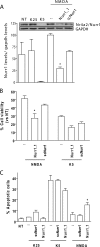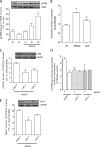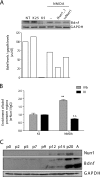Nurr1 protein is required for N-methyl-D-aspartic acid (NMDA) receptor-mediated neuronal survival
- PMID: 22294685
- PMCID: PMC3322860
- DOI: 10.1074/jbc.M111.272427
Nurr1 protein is required for N-methyl-D-aspartic acid (NMDA) receptor-mediated neuronal survival
Abstract
NMDA receptor (NMDAR) stimulation promotes neuronal survival during brain development. Cerebellar granule cells (CGCs) need NMDAR stimulation to survive and develop. These neurons differentiate and mature during its migration from the external granular layer to the internal granular layer, and lack of excitatory inputs triggers their apoptotic death. It is possible to mimic this process in vitro by culturing CGCs in low KCl concentrations (5 mm) in the presence or absence of NMDA. Using this experimental approach, we have obtained whole genome expression profiles after 3 and 8 h of NMDA addition to identify genes involved in NMDA-mediated survival of CGCs. One of the identified genes was Nurr1, a member of the orphan nuclear receptor subfamily Nr4a. Our results report a direct regulation of Nurr1 by CREB after NMDAR stimulation. ChIP assay confirmed CREB binding to Nurr1 promoter, whereas CREB shRNA blocked NMDA-mediated increase in Nurr1 expression. Moreover, we show that Nurr1 is important for NMDAR survival effect. We show that Nurr1 binds to Bdnf promoter IV and that silencing Nurr1 by shRNA leads to a decrease in brain-derived neurotrophic factor (BDNF) protein levels and a reduction of NMDA neuroprotective effect. Also, we report that Nurr1 and BDNF show a similar expression pattern during postnatal cerebellar development. Thus, we conclude that Nurr1 is a downstream target of CREB and that it is responsible for the NMDA-mediated increase in BDNF, which is necessary for the NMDA-mediated prosurvival effect on neurons.
Figures






Similar articles
-
NMDA receptor-dependent CREB activation in survival of cerebellar granule cells during in vivo and in vitro development.Eur J Neurosci. 2002 Oct;16(8):1490-8. doi: 10.1046/j.1460-9568.2002.02232.x. Eur J Neurosci. 2002. PMID: 12405962
-
Role of brain-derived neurotrophic factor in the protective action of N-methyl-D-aspartate in the apoptotic death of cerebellar granule neurons induced by low potassium.J Neurosci Res. 2007 Feb 1;85(2):332-41. doi: 10.1002/jnr.21112. J Neurosci Res. 2007. PMID: 17086548
-
Knockdown of the aryl hydrocarbon receptor attenuates excitotoxicity and enhances NMDA-induced BDNF expression in cortical neurons.J Neurochem. 2009 Nov;111(3):777-89. doi: 10.1111/j.1471-4159.2009.06364.x. Epub 2009 Aug 27. J Neurochem. 2009. PMID: 19712055
-
N-methyl-D-aspartate and TrkB receptor activation in cerebellar granule cells: an in vitro model of preconditioning to stimulate intrinsic survival pathways in neurons.Ann N Y Acad Sci. 2003 May;993:134-45; discussion 159-60. doi: 10.1111/j.1749-6632.2003.tb07522.x. Ann N Y Acad Sci. 2003. PMID: 12853306 Free PMC article. Review.
-
Nurr1-Based Therapies for Parkinson's Disease.CNS Neurosci Ther. 2016 May;22(5):351-9. doi: 10.1111/cns.12536. Epub 2016 Mar 25. CNS Neurosci Ther. 2016. PMID: 27012974 Free PMC article. Review.
Cited by
-
Involvement of the GluN2A and GluN2B subunits in synaptic and extrasynaptic N-methyl-D-aspartate receptor function and neuronal excitotoxicity.J Biol Chem. 2013 Aug 16;288(33):24151-9. doi: 10.1074/jbc.M113.482000. Epub 2013 Jul 9. J Biol Chem. 2013. PMID: 23839940 Free PMC article.
-
Molecular Insights into NR4A2(Nurr1): an Emerging Target for Neuroprotective Therapy Against Neuroinflammation and Neuronal Cell Death.Mol Neurobiol. 2019 Aug;56(8):5799-5814. doi: 10.1007/s12035-019-1487-4. Epub 2019 Jan 25. Mol Neurobiol. 2019. PMID: 30684217 Review.
-
Rhynchophylline Downregulates Phosphorylated cAMP Response Element Binding Protein, Nuclear Receptor-related-1, and Brain-derived Neurotrophic Factor Expression in the Hippocampus of Ketamine-induced Conditioned Place Preference Rats.Pharmacogn Mag. 2018 Jan-Mar;14(53):81-86. doi: 10.4103/pm.pm_90_17. Epub 2018 Feb 20. Pharmacogn Mag. 2018. PMID: 29576706 Free PMC article.
-
Revisiting the expression of BDNF and its receptors in mammalian development.Front Mol Neurosci. 2023 Jun 22;16:1182499. doi: 10.3389/fnmol.2023.1182499. eCollection 2023. Front Mol Neurosci. 2023. PMID: 37426074 Free PMC article.
-
Nurr1 Is Not an Essential Regulator of BDNF in Mouse Cortical Neurons.Int J Mol Sci. 2022 Jun 20;23(12):6853. doi: 10.3390/ijms23126853. Int J Mol Sci. 2022. PMID: 35743300 Free PMC article.
References
-
- Gould E., Cameron H. A., McEwen B. S. (1994) Blockade of NMDA receptors increases cell death and birth in the developing rat dentate gyrus. J. Comp. Neurol. 340, 551–565 - PubMed
-
- Ikonomidou C., Bosch F., Miksa M., Bittigau P., Vöckler J., Dikranian K., Tenkova T. I., Stefovska V., Turski L., Olney J. W. (1999) Blockade of NMDA receptors and apoptotic neurodegeneration in the developing brain. Science 283, 70–74 - PubMed
-
- Balázs R., Jørgensen O. S., Hack N. (1988) N-Methyl-d-aspartate promotes the survival of cerebellar granule cells in culture. Neuroscience 27, 437–451 - PubMed
-
- Altman J. (1972) Postnatal development of the cerebellar cortex in the rat. 3: maturation of the components of the granular layer. J. Comp. Neurol. 145, 465–513 - PubMed
Publication types
MeSH terms
Substances
LinkOut - more resources
Full Text Sources

